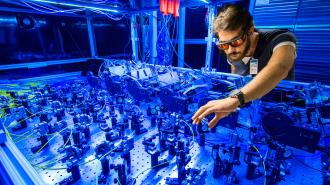For over half a century, researchers have studied the magnetic properties of an ephemeral subatomic particle called a muon. A recent measurement of this property is one of the most accurate measurements in all of science. However, when scientists compare their empirical result with a theoretical prediction, the two disagree. If this discrepancy is confirmed, it might require physicists to rewrite their theories describing the laws of nature. There’s a lot at stake.
Quantum foam
The muon is basically a heavier cousin of the familiar electron. Using the laws of quantum mechanics, it is possible to predict the strength of the magnetic field for these kinds of particles. In those calculations, the strength of the magnetic field is described by a dimensionless number called “g,” and it was predicted that g = 2 for electrons and muons. But shortly after the end of World War II, scientists precisely measured g for electrons and found that it was about 0.1% higher (that is, g ≈ 2.002). A measurement for muons gave the same result. What might appear to be a trivial difference is anything but; it led researchers to develop an improved form of quantum mechanics called quantum electrodynamics(QED).
QED contains all the oddities of traditional quantum mechanics and more. One new feature of QED is that it predicts that empty space isn’t empty at all. Instead, at the quantum level, space is a complicated and busy place, with subatomic particles appearing and disappearing almost instantly. This phenomenon is sometimes called quantum foam.
Quantum foam is the cause of the small shift in the muon’s magnetic properties. Because the muon has electric charge, it exerts a force on the particles of the quantum foam, with some particles being drawn closer, while others are slightly repelled. This alteration of the distribution of particles in the foam is what is responsible for the 0.1% discrepancy. Because researchers are interested in studying the quantum foam and not the more basic features of the muon, sometimes scientists studying this phenomenon subtract off the traditional value for g. The result is called “g-2” (“g minus 2”). The quantity g-2 focuses exclusively on the elusive and ephemeral quantum foam.
g-2 and counting
Over the decades, researchers made increasingly precise measurements of g-2. About a decade ago, scientists at Brookhaven National Laboratory in New York measured g-2 with seven digits of precision. However, when they compared it to the theoretical prediction, there was a tiny discrepancy. The two didn’t quite agree.
There are several possible explanations: (1) the measurement is wrong; (2) the prediction is wrong; (3) they’re both right — but there is some unknown phenomenon going on that is not incorporated into the accepted theory. If that is the case, the difference signals a discovery.
To verify that the measurement was correct, researchers moved their equipment from Brookhaven to Fermi National Accelerator Laboratory (Fermilab) to benefit from its more powerful accelerator. After considerable effort to improve the apparatus, the Fermilab researchers recorded data for several years, and their results — just now released — agreed with those from Brookhaven: The value of g-2 for a muon is 0.00233184110 ± 0.00000000047.
Problematic predictions
If the experimental measurement seems to be solid, what about the theoretical predictions? Here, the situation is more complicated. QED can, at least in principle, predict the effect of the quantum foam on the magnetic properties of the muon. The trouble is the calculation is extremely challenging. Some of the particles of the foam interact exclusively via electromagnetism, which is calculable; other foam particles experience what is called the strong force (which is responsible for holding the nuclei of atoms together), which is much more difficult to calculate.
To simply things, physicists used measurements from earlier experiments to replace the difficult parts of the theoretical calculation. However, other researchers took a different approach, using brute force computer power to calculate the effect of the strong force on the magnetic properties of the muon, an approach called “lattice QCD.” The lattice-based calculation disagreed with the earlier theoretical approach using experimental input and it also disagreed with the various direct measurements of g-2, albeit with a reduced discrepancy.
Given the disagreement in the theoretical community, a concerted effort is underway to resolve the issue, with some pursuing the technique of replacing difficult calculations with measurements and others refining the lattice calculations. Those taking the replacement approach are investigating the effect of using different experiments to supplement the QED calculation. Those following the computational methods are using refined calculations and bigger and more powerful computers. It is expected that resolving these theoretical issues will take several years to finish.
Does this mean new physics?
What if the theoretical community comes to a consensus, and the prediction still disagrees with the measurement? Researchers will be forced to conclude that the current theory is missing an important piece. If true, one possibility is that there are particles in the quantum foam that we don’t currently know about — a truly exciting prospect.
So, what’s next? The theorists will continue to refine their calculations, while the experimenters will continue to collect and analyze more data. (The goal of the Fermilab effort is to reduce the measurement uncertainties to a quarter of those reported by the Brookhaven group nearly two decades ago.) And, of course, other physicists are anticipating that the discrepancy between measurement and prediction will persist. These scientists are sharpening their pencils and scratching their heads, trying to figure out how to re-write existing theory.
This article was reprinted with permission of Big Think, where it was originally published.
